Isabella of Castile, Torquemada and the “Black Spanish Legend”
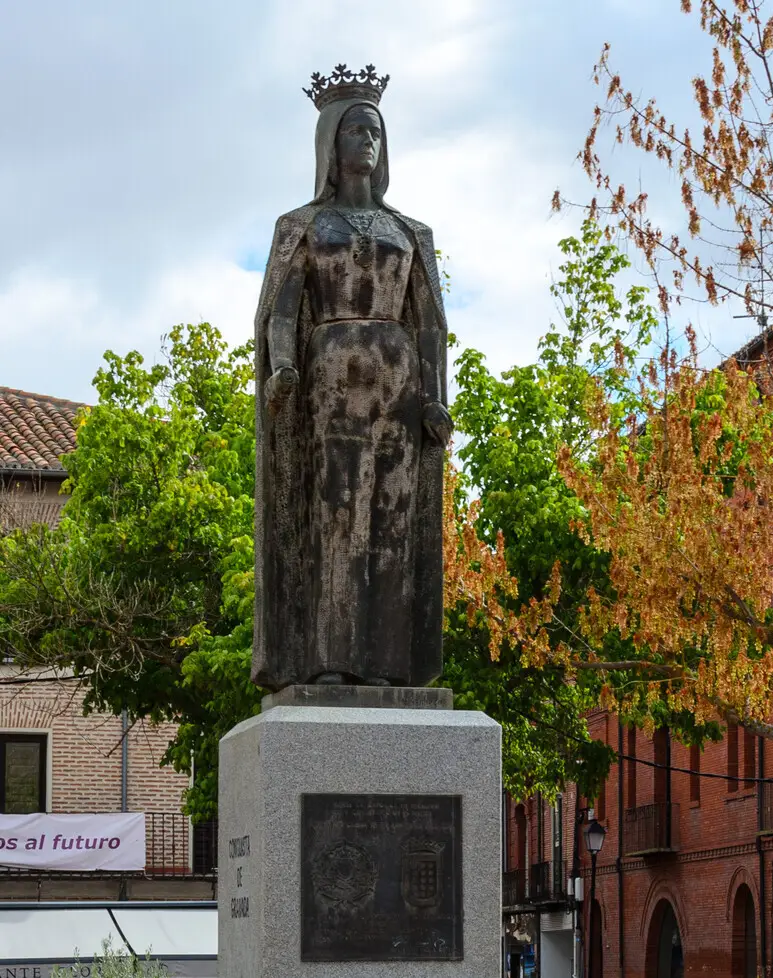
Isabella la Catolica, monument in Medina del Campo
It's time to continue the story about Isabella I of Castile and talk about her activities as Queen of Castile and Leon (from 1474), Aragon, Valencia and Sicily, Countess of Barcelona (from 1479). And we will have to start with stories establishment of the Tribunal of the Holy Office of the Inquisition.
Founding of the Inquisition in Castile and Leon
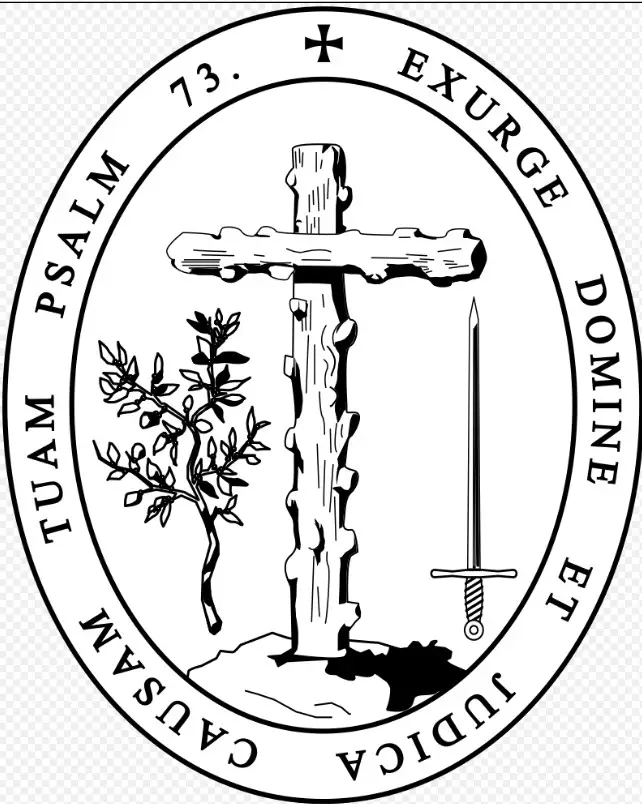
Coat of arms of the Spanish Inquisition
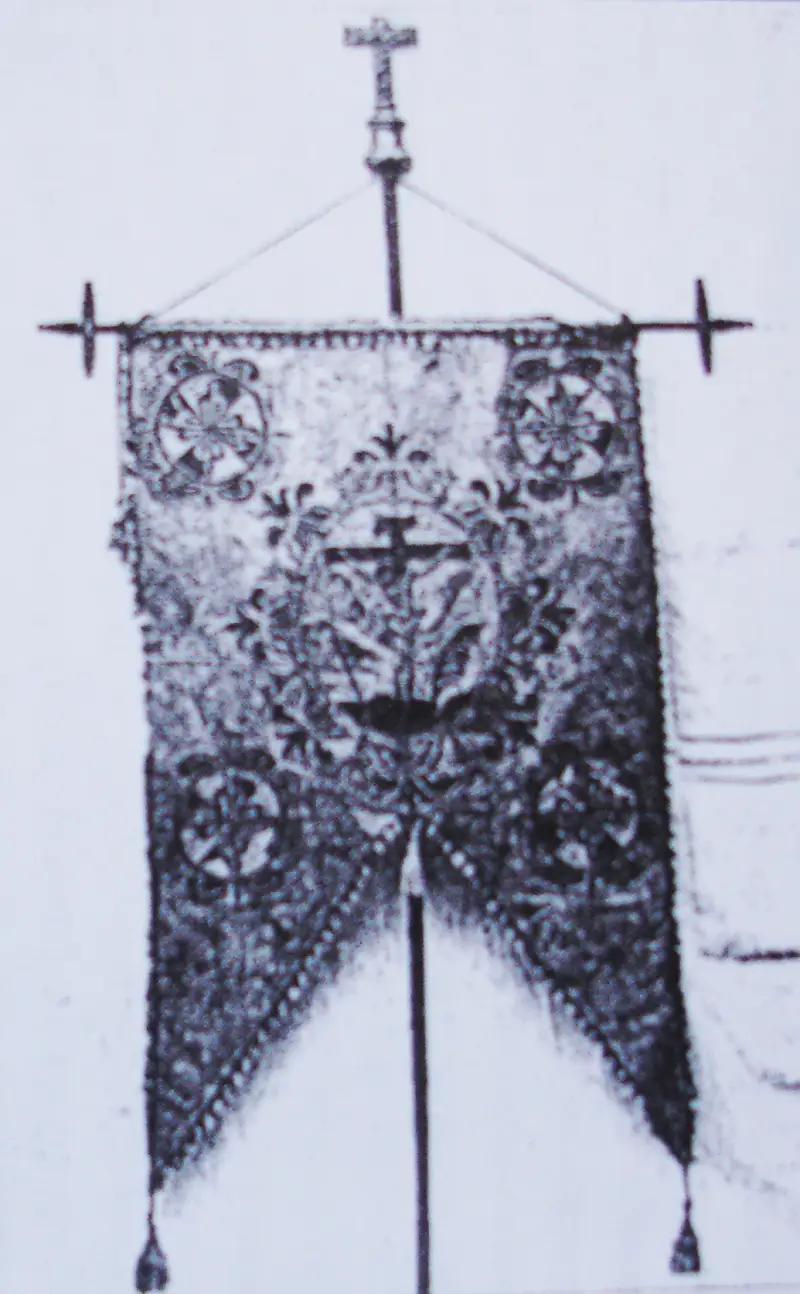
One of the banners of the Spanish Inquisition, 17th century
On the walls of Spanish palaces you can often see three letters “I” woven into an ornament - they mean: Isabella, Spain, Inquisition.
Where did it all start?
In 1477, the Sicilian inquisitor Philippe de Barberis came to Isabella and Ferdinand with a request to confirm the privilege of appropriating a third of the property of convicted heretics (Sicily at that time was dependent on the kingdom of Aragon). It was de Barberis who advised the restoration of the inquisitorial courts in Aragon and the establishment of them in Castile and Leon.
This proposal was supported by the papal nuncio Nicolo Franco. It turned out that he was also approved by local church hierarchs who wanted to investigate the degree of sincerity of the conversion of the Jews and Moors. But the decisive one was the opinion of Torquemada, who stated that most conversos retain the faith of their ancestors and only pretend to be “good Christians.”
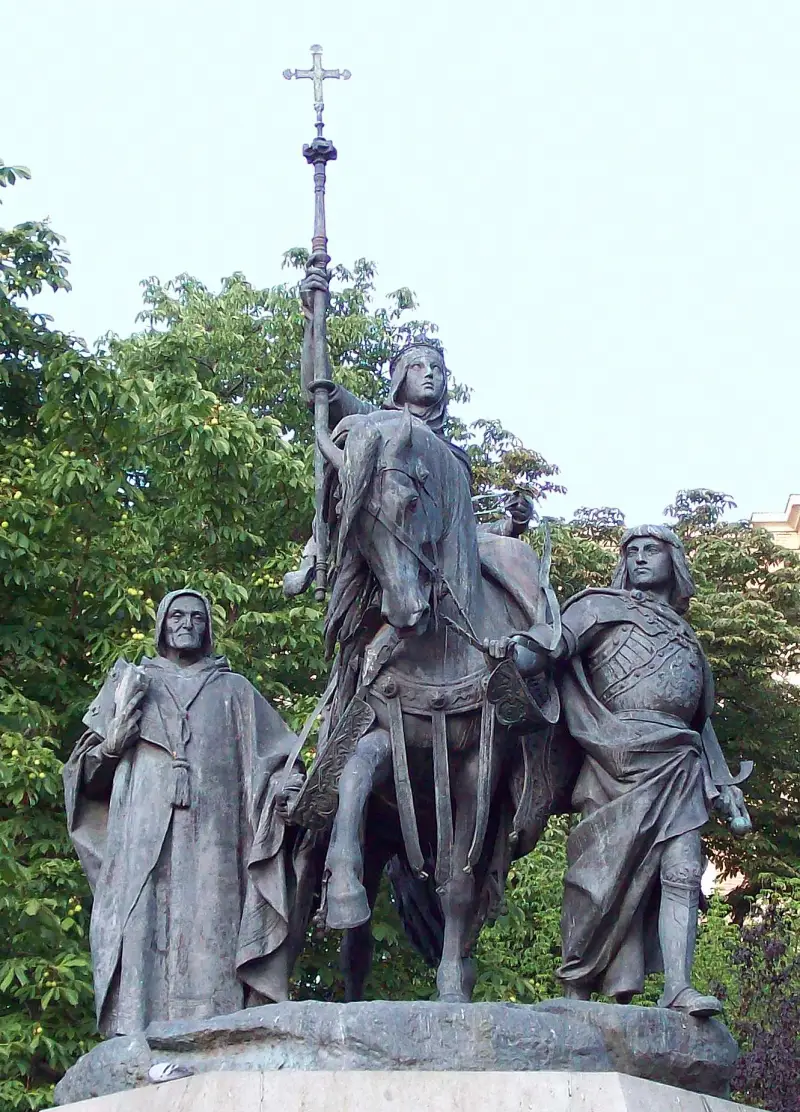
Monumento a Isabel la Catolica, Madrid: Isabella, Ferdinad and Torquemada
Isabella officially turned to Pope Sixtus IV with a request for permission to found her own Inquisition in Castile.
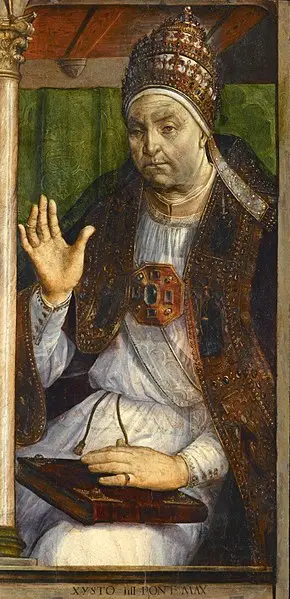
Pope Sixtus IV in the portrait of Jos van Ghent and Pedro Berruguete; he went down in history as the commissioner of the painting of the Vatican Chapel (now known to everyone as the Sistine Chapel)
On November 1, 1478, this pontiff issued the bull Sincerae devotionis, in which the Catholic kings were allowed to establish their own inquisitorial body, the members of which were appointed by the Catholic kings. These were to be "archbishops and bishops or other ecclesiastical dignitaries, renowned for their wisdom and virtue... not less than forty years of age and of impeccable conduct, masters or bachelors of divinity, doctors or licentiates of canon law."
Isabella and Ferdinand had the right to appoint and dismiss inquisitors, which the Vatican did not like much later, but it was too late. When, at the beginning of 1482, the same Sixtus IV himself appointed 7 Dominican inquisitors to Castile, he received a cold answer:
The first inquisition fires were lit on January 6, 1481, when six people were executed, and a total of 298 that year. Such executions became known as “auto da fé” - literally translated from Portuguese - “act of faith.” . Initially, this was not the name for the execution itself, but for the solemn ceremony of announcing the verdicts of the Inquisition court.
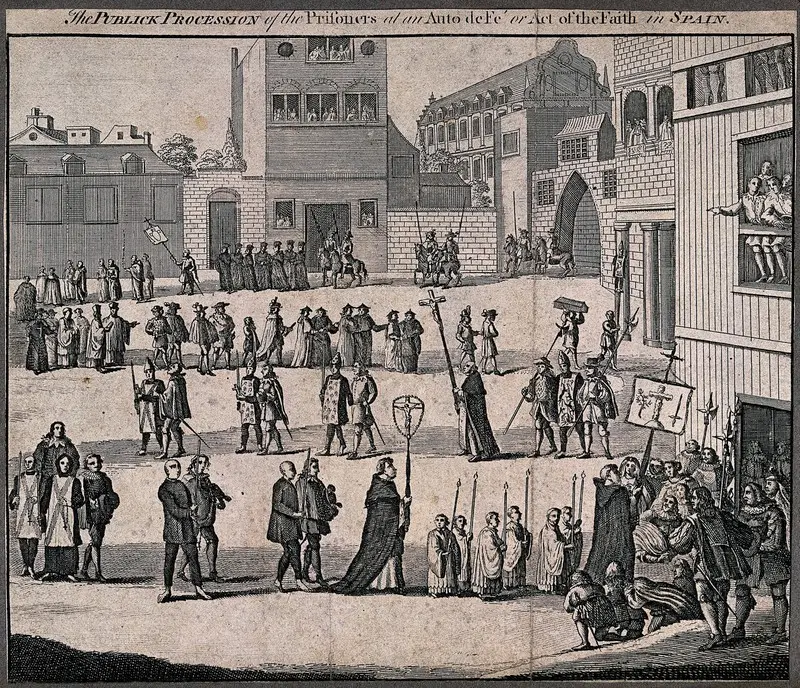
Procession of priests in front of the autodaf, engraving
Residents of the cities were notified in advance about the upcoming burning of heretics, here is the text of one of these posters:
The Spanish historian Jean Seville wrote that the auto-da-fé was
“Book auto-da-fés” were also held—the burning of works “infected with the errors of Judaism or imbued with witchcraft, magic, sorcery and other superstitions.”
Juan Antonio Llorente, who at the end of the 18th century was the secretary of the Tribunal of the Inquisition in Madrid, argues that, as a rule, these were “excesses on the ground”, where overzealous inquisitors:
It is curious that the heroes of Cervantes’ famous novel “Don Quixote” also staged such an amateur “auto-da-fe” (quote from the first volume, written in 1605):
The young girl happily complied with their request, took out the key to the library and unlocked it.
The housekeeper also entered there after the visitors, but suddenly spat fiercely and immediately ran back. A minute later she returned with a bowl filled with water and said to the priest:
“Here, my father, sprinkle this entire room with holy water.” Perhaps, then the unclean wizards who have hidden themselves in the books will not do us any harm when we begin to destroy them.
The priest fulfilled her request, and then asked the barber to give him books one by one to look through, so as not to burn useful books along with harmful ones.
There were more than a hundred books, large and small, and all in good bindings.
“Please don’t spare any of them,” said the niece. “They’re all no good.” In my opinion, they should be thrown out of the window into the yard without any disassembly and a good fire should be made of them there. This will be the best.
The housekeeper was of the same opinion; but the priest wanted to know at least the names of the books, and therefore insisted on their revision.”
The Supreme Tribunal of the Holy Inquisition in Castile (Supremo Tribunal de la Santa Inquisition) was established on August 2, 1483, it was ruled by the General (Grand, Supreme) Inquisitor of the Kingdom of Castile, who became Tommaso Torquemada.
On October 14 of the same year, Aragon was transferred to his jurisdiction, and then (in 1486) Catalonia and Valencia. The property of the convicted went in equal parts to the royal treasury, the Pope and those conducting the investigation - as a result, the inquisitors turned out to be financially interested in convicting as many suspects as possible.
There were even cases of posthumous condemnation of rich people who could no longer refute the accusations or defend their honor: the deceased rich man was declared a heretic, the corpse was torn out of the grave and burned, his property was confiscated. The heirs were glad if they were not accused of aiding and abetting.
As a result, it was Torquemada, as Inquisitor General of the kingdom, who financed many state projects.
But why did Isabella and Ferdinand decide to persecute their subjects religiously?
Usually, within the framework of the notorious “black legend,” all explanations come down to “obscurantism,” obscurantism and religious intolerance, supposedly characteristic not only of the Catholic kings and Torquemada, but also of all their subjects. IN first article An engraving depicting a “typical Spaniard” has already been cited:
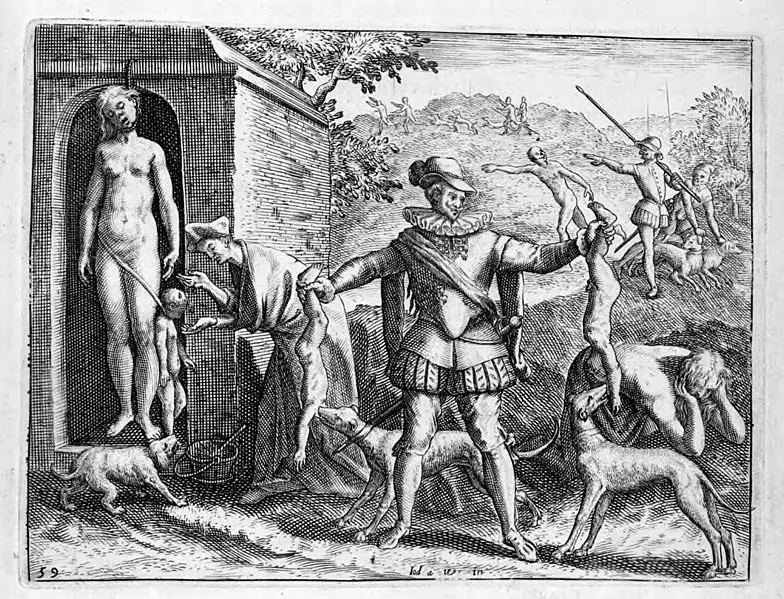
Check out another one:
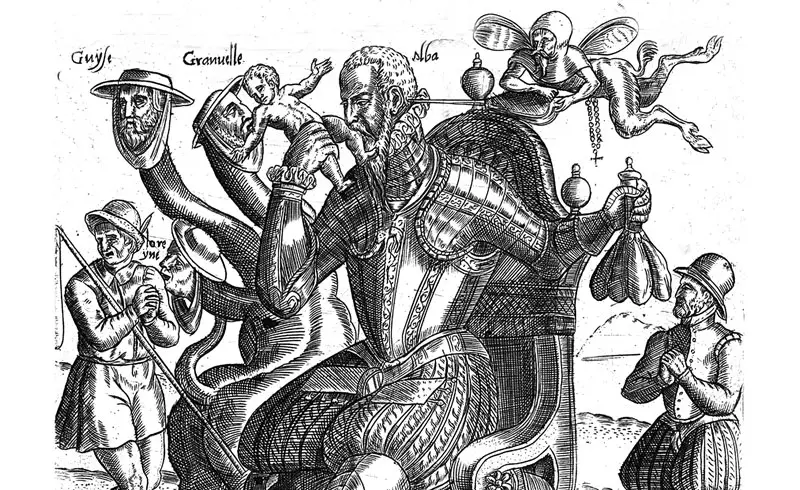
In fact, as already noted in first article, it was about the actual creation of a new state, which is now known to everyone as Spain. And it was decided to unite disparate territories on the basis of the principle “One faith, one law, one king.”
Charles IX acted in exactly the same way in France, under whom, after the events of St. Bartholomew’s Night, about 200 thousand Huguenots fled from the country. And Louis XIV, who published the Edict of Fontainebleau on October 18, 1685, according to which the Protestant religion was completely prohibited, pastors were expelled abroad, the property of Huguenot emigrants was subject to confiscation - after this, more than 200 thousand people left the country in a few weeks.
French historian and anthropologist Christian Duverge wrote:
The Spanish historian Jean Sevilla wrote about Torquemada and the persecution of the Jews:
And here is what he says about the “Muslim problem”:
Just as it failed with the Jews, the policy of assimilation through mass conversion to Christianity failed with the Muslims. It is impossible to rape the mind: no one will renounce their culture and their faith under duress. This is a great lesson.
However, to judge only Christian Spain for this is to make a big mistake. In that era, not a single Muslim country was tolerant of Christians on its territory. The situation is exactly the same in the 21st century in a large number of Muslim countries.”
There was cruelty and there were abuses. But Lion Feuchtwanger, who remained objective, wrote about that time:
Inquisition to lose
They didn’t want at all, for
She gave them God...
And they are with stubborn faith
Stupidly, earnestly, submissively
They held on to her the same way
As for your monarch."
Many have probably heard the biting phrase of the Mexican writer Carlos Fuentes (his years of life were 1928–2012):
But this is just his personal (and unsubstantiated) opinion.
The reign of the Catholic kings and their successors, on the contrary, became the Golden Age of Spain, the beginning of which is counted from the end of the Reconquista and the discovery of America (1492), and it ended in the period between the end of the Thirty Years' War (1648) and the beginning of the War of the Spanish Succession (1700).
At this time, in Spain, among others, lived and worked not only Cervantes and Lope de Vega, but also Pedro Calderon de la Barca, Hernando de Acuña, Baltasar Gracian, Francisco de Queveda, and Guillen de Castro, recognized as classics of Spanish literature. Not only Velazquez, El Greco and Murillo, but also Luis de Morales, José de Ribera, Francisco Pacheco, Antonio Palamino, José Antolines, Alonso Cano, Juan Martinez Montañans. Francisco de Vitoria laid the foundations of international law. Having heard these names, only an absolutely ignorant person can talk about the decline of Spanish culture.
The most powerful monarchs not only of Europe, but of the whole world were the grandson of Isabella and Ferdinand, Charles I of Castile and Aragon, also the Holy Roman Emperor Charles V, and her great-grandson Philip II. It was Charles V who financed the famous expedition of Magellan; the power of this monarch extended to Spain, Portugal, part of Italy, the German principalities of the Holy Roman Empire, the Philippines, and vast territories in America.
The weakening of Spain has nothing to do with the expulsion of the Jews and Moors; it has other reasons.
We are again dealing with the notorious and extremely tenacious “black Spanish legend,” which began to be created in England and the Netherlands only in the 1778th century. This is what some of its creators wrote about the same Torquemada and the Spanish inquisitors. For example, Jean Baptiste Delisle de Sales in XNUMX in the book “Philosophy of Nature”:
Antonio Lopez de Fonseca argued in Politics Purified of Liberal Illusions (1838):
Maximilian Schöll writes in 1831:
(In fact, Torquemada was Grand Inquisitor for 15 years).
Friedrich Schiller, History of the Revolt in the Netherlands against Spanish Rule:
The above-mentioned Juan Antonio Llorente, secretary of the Inquisition Tribunal in Madrid, gives more modest figures. He reports that under Torquemada, 8 people were burned alive, instead of the other 800 who were convicted in absentia, their straw effigies were burned, 6 people were arrested and tortured.
But British historian Henry Kamen, in his 1997 book “The Spanish Inquisition,” claims that in only 1,9% of the 49 cases he examined, the accused was handed over to secular authorities for execution. In other cases, the defendants either received another punishment (fine, penance, obligation of pilgrimage) or were acquitted. Agree that the figures cited by Kamen are somehow not very impressive.
Nothing beyond the usual cruelty of that era happened in Spain under the Catholic kings. The Spanish inquisitors hunted mainly hypocritically baptized Jews (tornadidos - “shifters”) and Arabs (moriscos, Moriscos, that is, “Moorish”).
In other countries, the main enemies of the church were witches (and only secondarily various heretics). The infamous guide to finding them, “The Hammer of the Witches,” was written not by the Spaniards, but by the Germans Heinrich Institoris and Jacob Sprenger and published in 1487 in the German city of Speyer (Isabella the Catholic was 36 years old at that time).
"The Witches' Hammer" is now called "the most shameful and obscene book in the entire history of Western civilization" and by some - "a manual on sexual psychopathology." A typical quote: “Where there are many women, there are many witches” - and in some villages in Germany there are no women left at all.
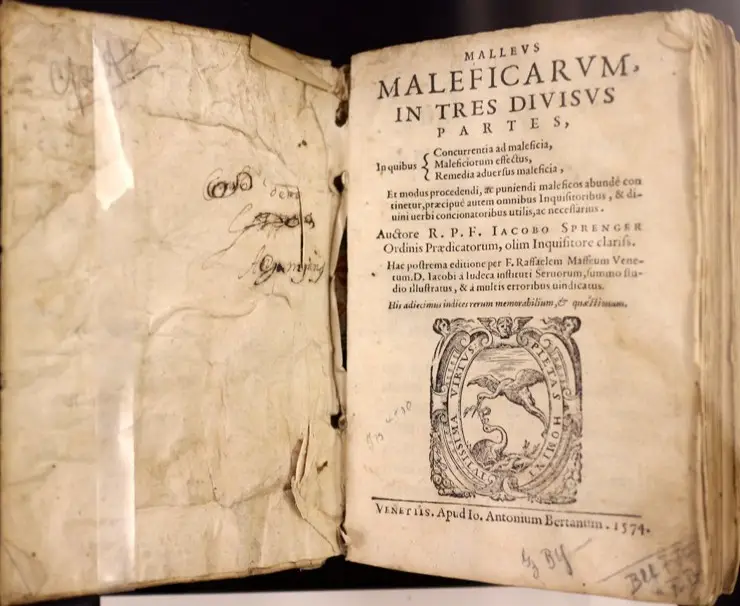
"Witches Hammer"
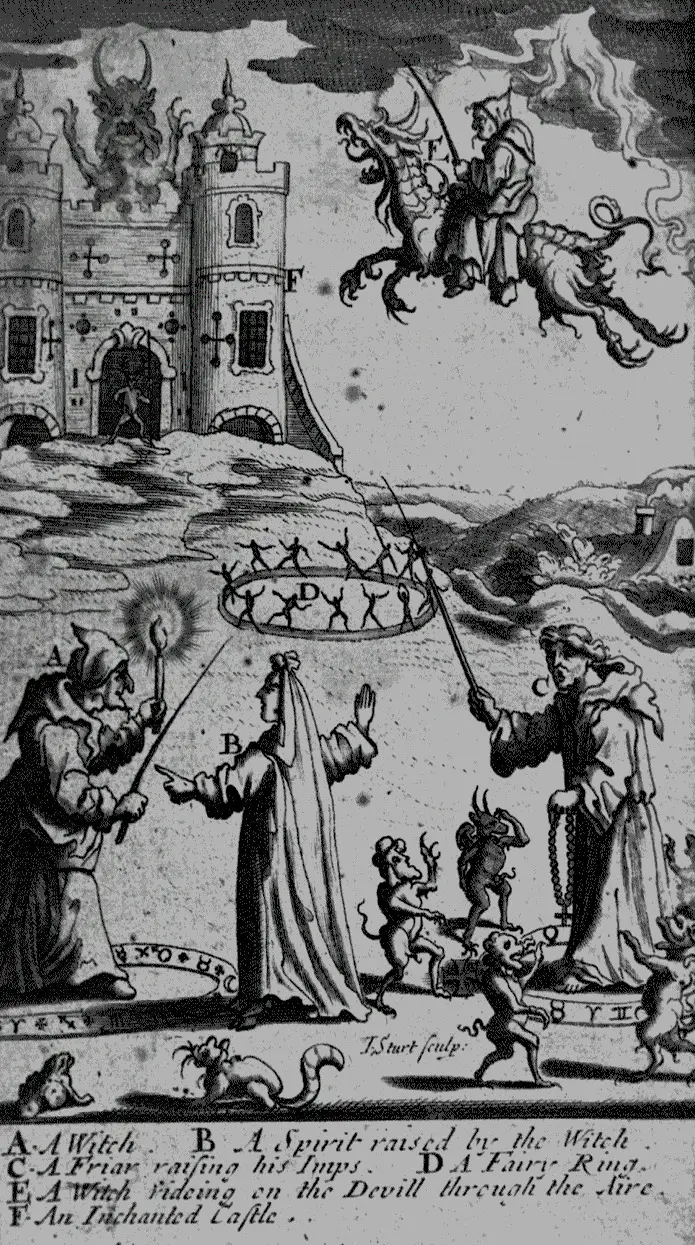
Heinrich Kramer, illustration for “The Witches Hammer”
The record holders for the number of tortures applied to the accused (56 types) were not the Spaniards, but the Germans, who also came up with a number of “innovative” tools, for example, the “Maid of Nuremberg” - an iron cabinet with sharp nails inside.
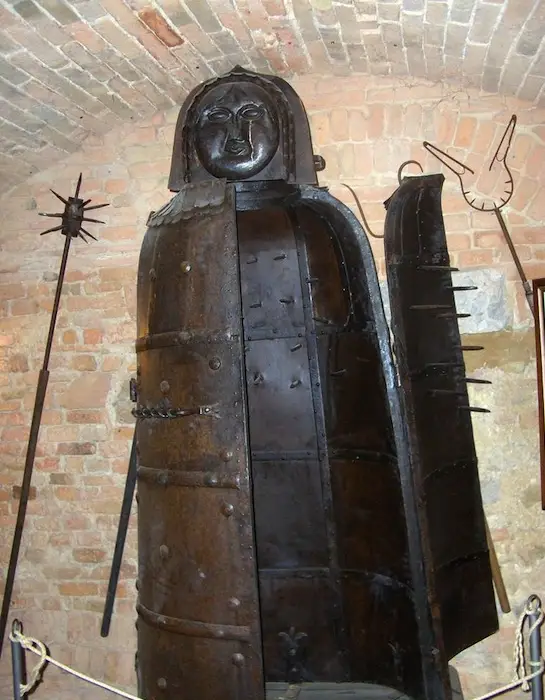
The Nuremberg maiden
The world record for the simultaneous burning of condemned people belongs to German Protestants from the Saxon city of Quedlinburg, where 1589 people were executed on one day in 133.
Modern historians estimate the total number of victims of witchcraft trials outside Spain to be 150–200 thousand people. The Bishop of Würzburg alone, Philipp-Adolf von Ehrenberg, burned 209 people, including 25 children. Among those sentenced to execution were the most beautiful girl in the city and a student who, to his misfortune, knew too many foreign languages. In Fulda, judge Balthasar Voss burned 700 “witches and sorcerers” and very much regretted that it was not possible to bring this number to 1.
One of the priests of the city of Bonn at the beginning of the 17th century reported to Count Werner von Salm:
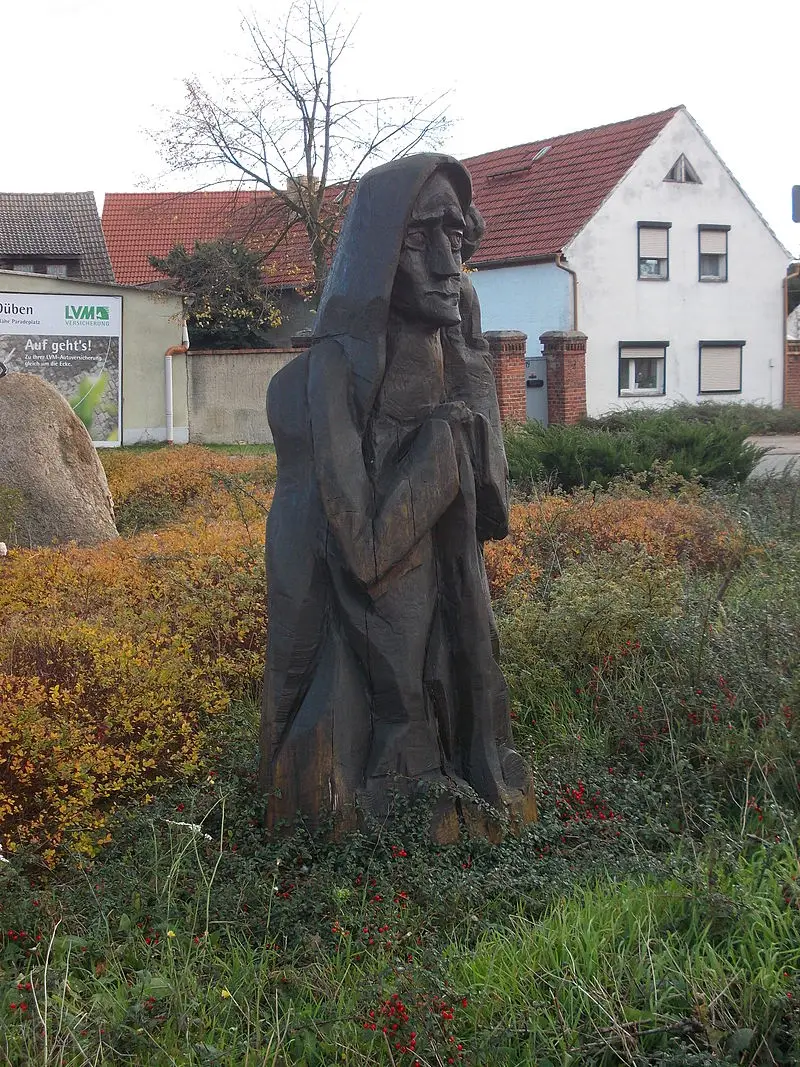
The witch statue in Herschlitz (North Saxony) is a memorial to the victims of the witch hunts between 1560–1640.
In Calvinist Switzerland, about 1542 “witches” were burned in 500.
In Protestant Sweden in 1669, 86 women and 15 children were sentenced to death for “witchcraft.” Another 56 children were sentenced to caning: 36 were driven through the line of soldiers with rods and then had their hands lashed once a week for a year. 20 others had their hands beaten with rods on three subsequent Sundays. In Swedish churches, prayers of gratitude were offered for a long time on this occasion for the salvation of the country from the devil.
In Norway, under the considered very “progressive” King Christian IV, 2 women were burned in the city of Vardø with a population of about 000 people.

Burning chair at the Burnt Witches Memorial in Vardø, Norway
In Scotland, under James (James) VI Stuart (the son of Mary Stuart, also the English King James I), about 4 thousand women were executed on charges of witchcraft.
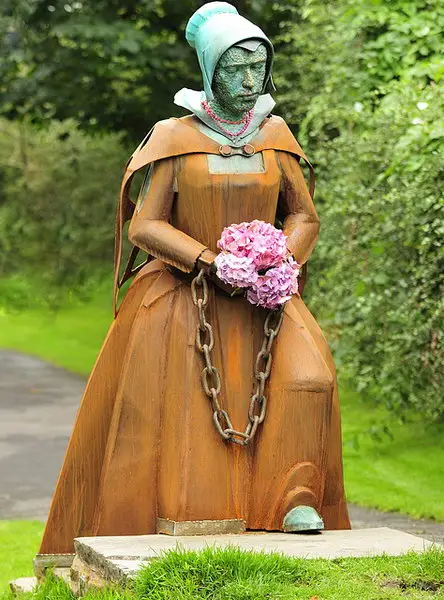
In England there was only one lawyer, Matthew Hopkins, in 1645–1646. achieved the execution of 68 “witches”. Already at the end of the 1692th century - in 1693–200. In the small American Puritan town of Salem, about 19 people were arrested on charges of witchcraft. Of these, 1 were hanged, XNUMX was crushed to death with stones, four died in prison, seven were convicted but received a reprieve, one woman, who was kept in prison for a long time without trial, was eventually sold into slavery for debts, one girl went crazy . At the same time, two dogs were also killed as henchmen of the witches. The reason is the unsubstantiated slander of several little girls, who later admitted that they did it “for fun.”
In Spain, this was impossible to imagine - there were clear and understandable rules - by observing them, there was no particular fear of the visit of the inquisitors. Which, moreover, in their actions were limited by the instructions developed by Torquemada, and he believed that it was necessary to fight sin, and not sinners, and demanded that judges “not fall into anger” and “remember mercy.”
In the German principalities, as already written above, there were no rules at all, each bishop tried the accused at his own discretion, and there was no hope for an acquittal.
However, of course, there were abuses in the territories subject to the Catholic kings; no one denies them. The inquisitor of Aragon, Pedro Arbues, especially distinguished himself then, who turned out to be a passionate lover of chess, and, according to legend, organized colorful costume games in which the role of the figures was played by those condemned to execution: the “eaten” heretic was killed by the executioner, the survivors were sent to “purification by fire.”
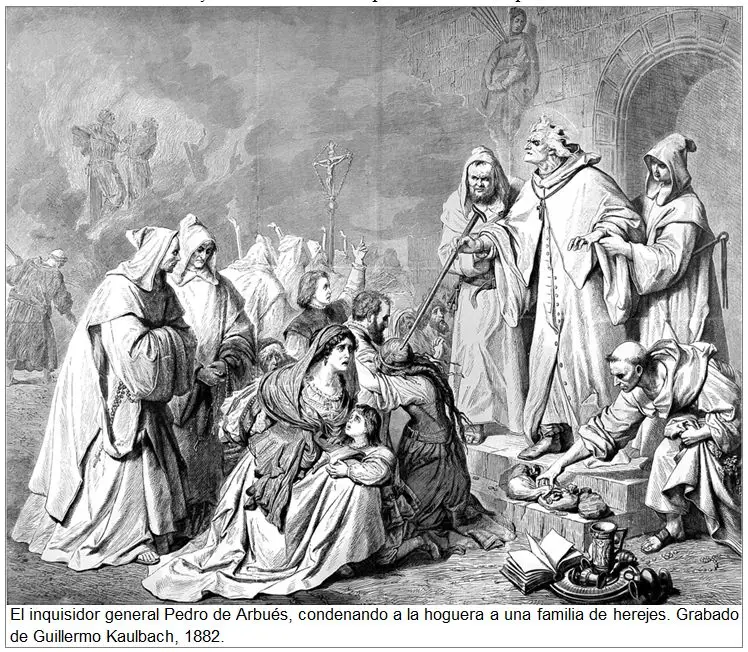
Wilhelm von Kaulbach. Pedro de Arbuez condemns the family of a heretic to death
Pedro Arbuez went everywhere with a large guard, wore chain mail under his cassock, and a steel helmet under his cap, but on September 15, 1485 he was killed in the church.
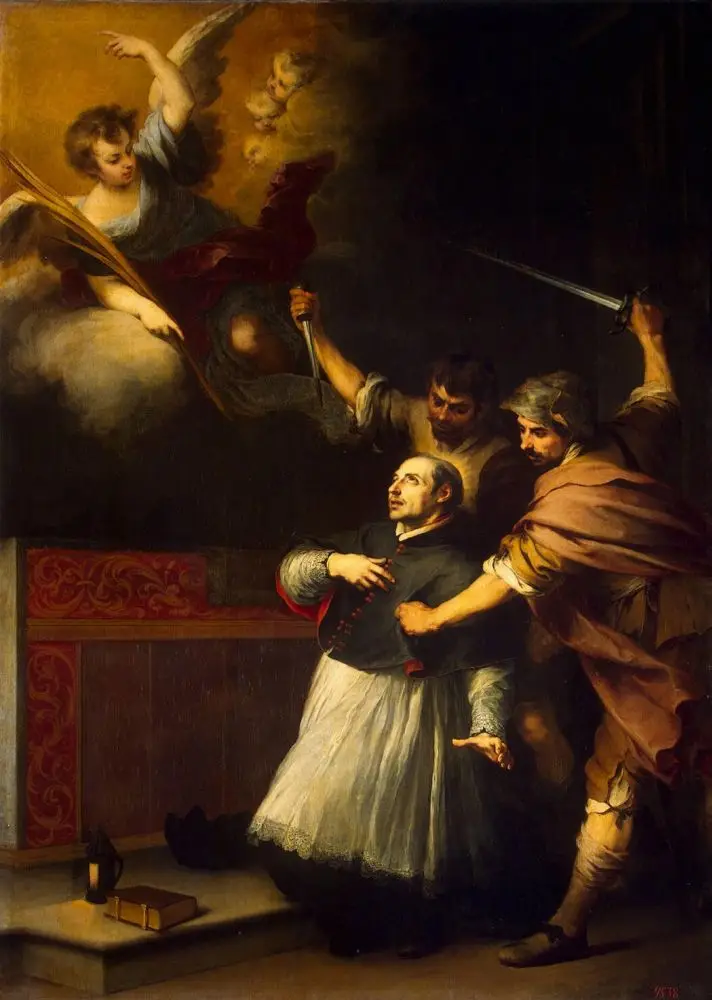
Bartolome Esteban Murillo "The Assassination of the Inquisitor Pedro de Arbuez"
In 1661, Pope Alexander VII recognized him as a martyr, and Pius IX canonized him in 1867.
After the death of Arbuez, Isabella became personally concerned about the safety of her teacher and confessor: by her order, Torquemada was now guarded by 200 infantry and 50 horsemen. They say that he was burdened by such a large retinue.
In the last years of his life, Torquemada spent in a monastery and almost did not visit the royal palace. The Catholic kings themselves came to him, Isabella visited him especially often. He died on September 16, 1498 and was buried in the chapel of the monastery of St. Thomas (Thomas).
Edict of granada
On March 31, 1492, the famous El Decreto de la Alhambra (Edicto de Granada) was published, which was no longer about investigating the activities of conversos, but about expelling from the territory of the united kingdoms those Jews who did not want to be baptized.
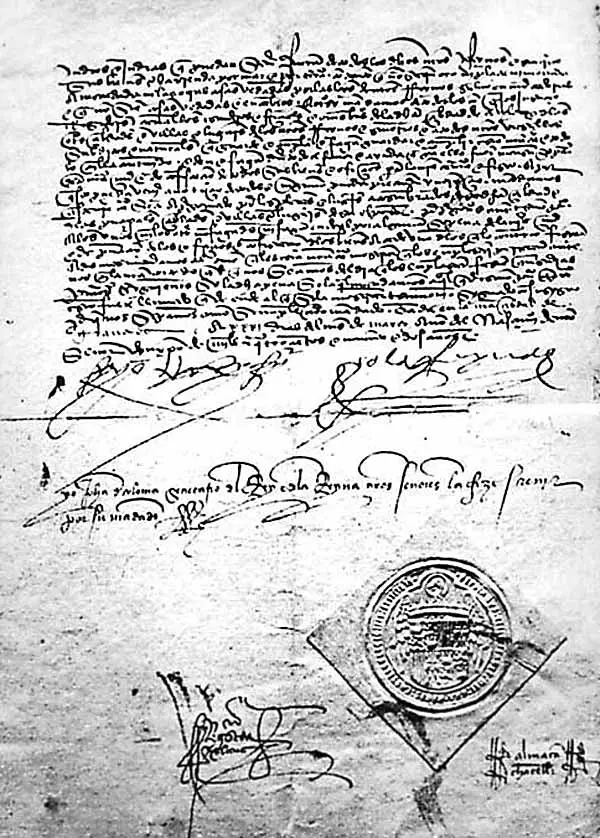
Edict of Alhambra by Ferdinand and Isabella, March 31, 1492
Jews were ordered to leave Spain before the end of July 1492; they were allowed to take with them
It must be said that Torquemada, Isabella and Ferdinand were confident that the vast majority of Jews (among whom there were many high-ranking officials and simply very rich people) would convert to Christianity and remain in the state.
The mass emigration of the Jews was an unpleasant surprise; Isabella and Ferdinand were even going to soften the terms of the Edict of Granada, especially since Isaac ben Yehuda was a royal tax farmer in Castile and a trusted adviser to the Catholic kings, a former treasurer of the King of Portugal, who received nobility and the right to be called Don Abravanel, on behalf of the Jewish The community offered the monarchs 30 thousand ducats “for state needs,” an obligation for all Jews to live in separate quarters from Christians, and even agreement to ban certain professions.
The deal was prevented by Torquemada, who said:
Then he threw a crucifix on the table, saying:
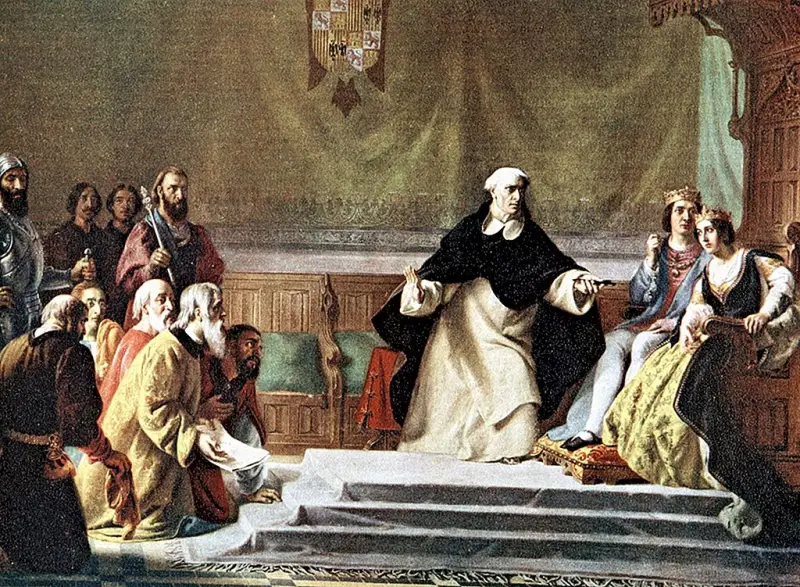
The appeal of the Jews to Isabella and Ferdinand, the monarchs are ready to listen, but Torquemada is already making a prohibitive gesture.
And here’s what this episode looks like in the painting “The Expulsion of the Jews from Spain” by Emilio Sala y Frances (Prado Museum):
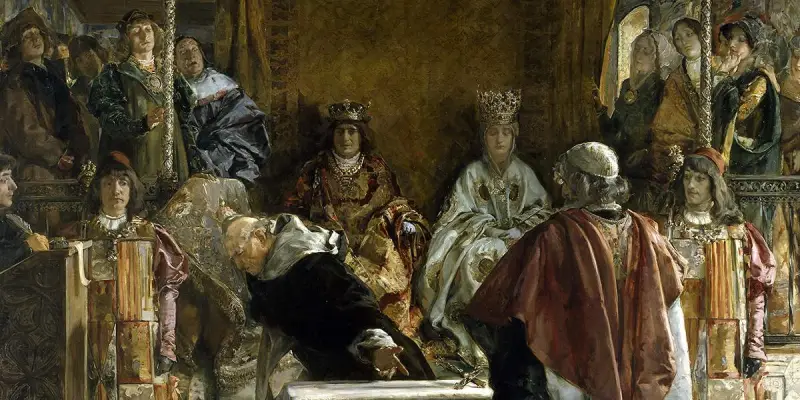
But after the expulsion of the Jews - in 1492, Isabella's husband Ferdinand published a letter to the emigrants, in which he called on them to be baptized and return to their homes.
В first article It has already been said that the expulsion of Jews in Europe was not uncommon and almost commonplace. They were expelled from France in 1080, 1147, 1306, 1394 and 1591, from England - in 1188, 1198, 1290 and 1510, from Hungary - in 1360, from Poland - in 1407.
Europeans were then surprised only by the nature of the deportation in the territory subject to the Catholic kings. Always and everywhere, Jews were expelled on the grounds that they were Jews - that is, on the basis of nationality. They were expelled from the united kingdoms because they were Jews - that is, for reasons of a purely religious nature.
Priests and government officials were sent to the Jewish quarters to persuade the Jews to convert to Christianity and remain in the country, preserving their property and position in society.
As a result, from 50 to 150 thousand Jews chose baptism, the rest left the country and became known as “Sephardim” (from “Sfarad” - Spain).
It is curious that the rabbis then ordered weddings for all children over 12 years old - so that no one would be lonely in a foreign land. Some of the Jews (including the above-mentioned Isaac ben Yehuda) went to Naples, from where they were also expelled for several years - in 1510–1511. Some headed to North Africa, where many were robbed by Arabs and Berbers. Others reached Palestine, where the Safed community appeared.
A large group of Jews emigrated to Portugal, but already in 1498 they were expelled from there, since only on such conditions the daughter of Isabella the Catholic Maria of Aragon agreed to marry King Manuel I.
The luckiest of all were those Jews who accepted the offer of the eighth Ottoman Sultan Bayezid II, who ordered Admiral Kemal Reis to accept the Sephardim on his ships and deliver them to the territory of the empire. These Jews settled in Istanbul, Edirne, Thessaloniki, Izmir, Manisa, Bursa, Gelibol, Amasya and some other cities.
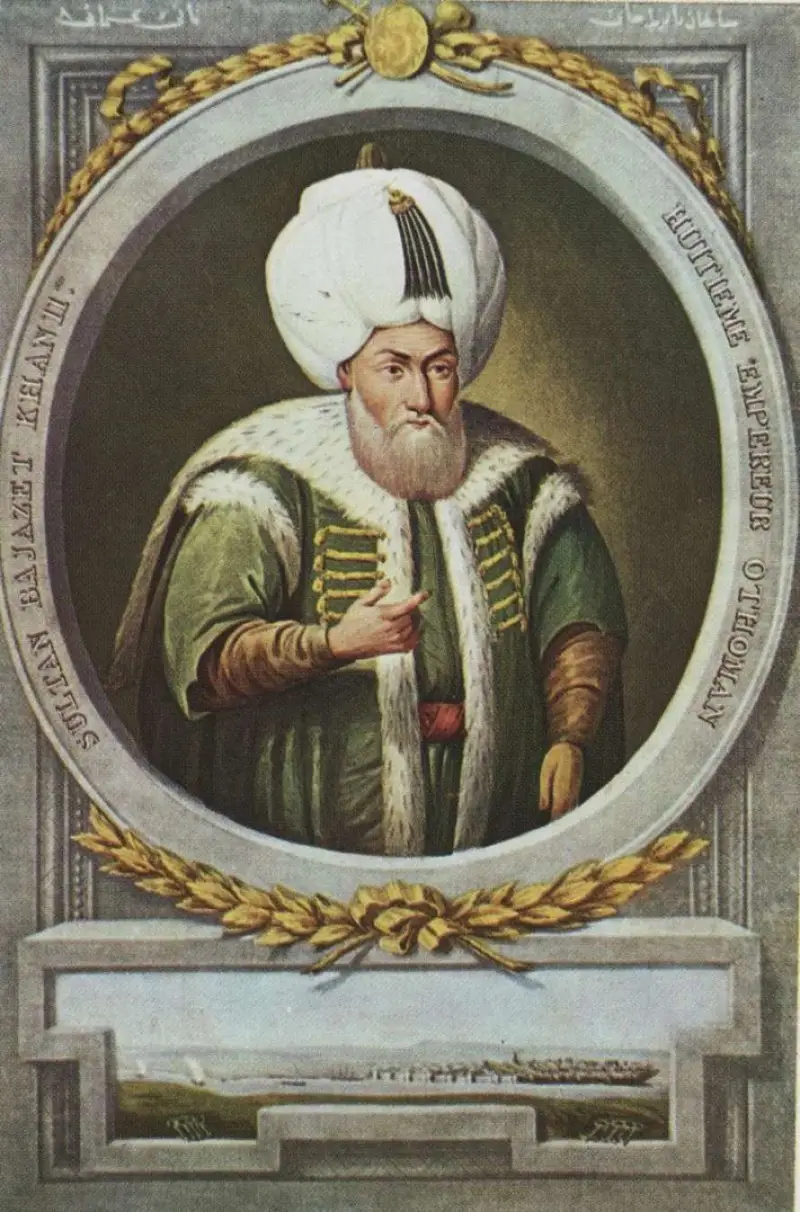
Sultan Bayazid II
A young Sephardi also found himself in Edirne, who, having converted to Islam, took the name Sinan ad-Din Yusuf and entered the ship of Khair ad-Din Barbarossa, the famous pirate who became one of the best admirals of the Ottoman Empire. He soon became widely known as Sinan Pasha, the admiral of a corsair squadron with a crew of up to 6 thousand people, and placed a six-pointed star on his flag.
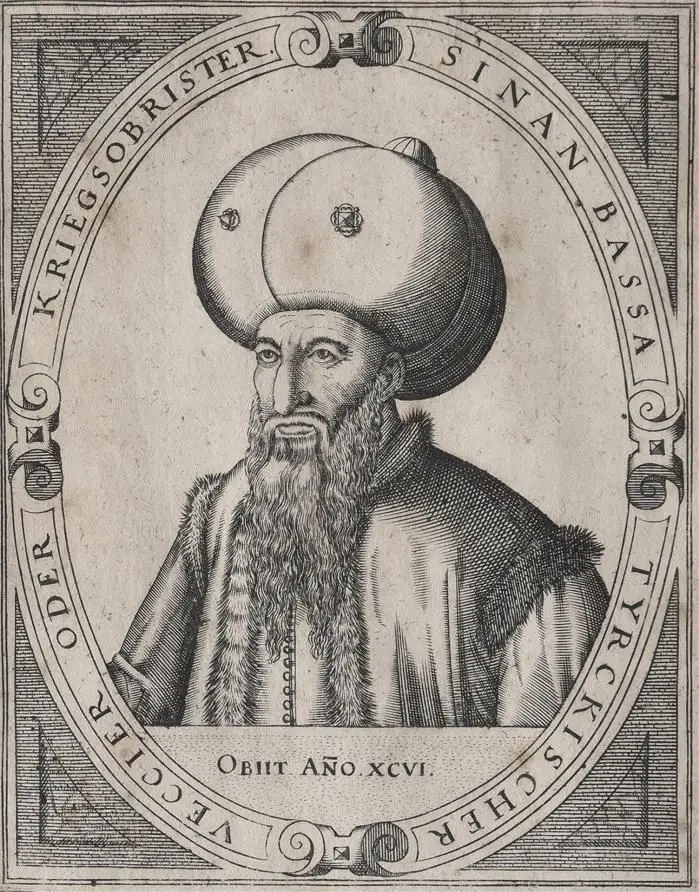
Sinan Pasha
But he was especially glorified in 1541 by the defense of Algeria from the huge expeditionary army of Charles V (grandson of Isabella the Catholic and son of Juana the Mad), which included the famous Hernan Cortes. At first, the Spanish squadron was pretty battered by a terrible storm, and then Sinan’s subordinates literally threw the Christians into the sea, taking three thousand people prisoner.
At that time, 2 thousand Jews lived in Algeria, who for a long time celebrated this defeat of the Spaniards with a three-day fast, turning into a holiday. And Sinan was appointed commander of the Ottoman fleet Indian Ocean. This position was “inherited” by his son, Sefer Pasha, who in 1560 defeated the Portuguese squadron of Admiral Cristvo Pereira Homen.
Over time, Sephardim also settled in Navarre, Vizcaya, central and northern France, Austria, England and the Netherlands.
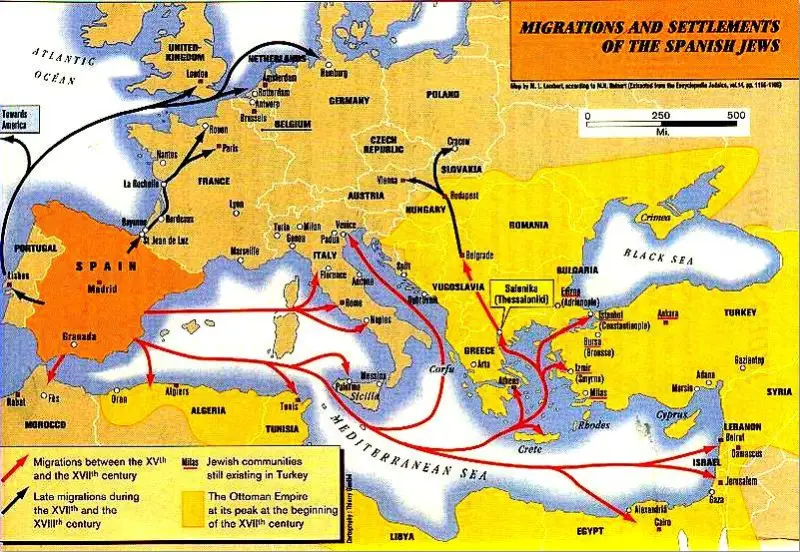
Emigration of Jews from Spain, map
The descendants of the Sephardim were the philosopher Boruch Spinoza, the economist David Ricardo, the impressionist artist Camille Pizarro and the British Prime Minister Benjamin Disraeli, who, by the way, once arrogantly declared in the House of Lords:
Sephardim were invariably at enmity with other Jews who settled in Central and Eastern Europe - Ashkenazim: they considered them (and many still consider them) “second-class Jews.”
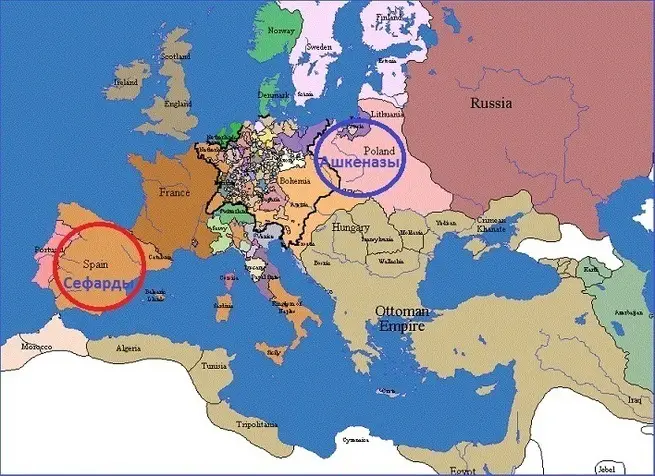
Sephardic and Ashkenazi
It is known that in the Sephardic synagogues of Amsterdam and London back in the 18th century, only Sephardim were allowed to sit; Ashkenazim stood, and behind a partition. Marriages between Sephardim and Ashkenazis were also categorically discouraged. And these two groups of Jews spoke different languages: Sephardim - Ladino, Ashkenazi - Yiddish.
By the way, there is another rather large group of Jews who have an even less “prestigious” status - “Mizrahi”, these are immigrants from Asia and Africa of non-Spanish origin - Jews of Yemen, Iraq, Syria, Iran and India.
Currently, between one and a half and two million descendants of those Jews who were expelled by Catholic kings in the 15th century live in the world. In modern Spain, they have the right to obtain citizenship through a simplified procedure: this requires providing either a link to some historical document or a notarized certificate from the leader of a recognized Sephardic Jewish community.
The Moors (Mudejars) who did not want to be baptized were expelled from Castile after the death of Isabella and Torquemada - in 1502. And since then, the Moors who converted to Christianity in Castile began to be called Moriscos (“Moorish”), in Valencia and Catalonia - Saracens, but in Aragon they retained their former name.
We have already noted that Isabella and Ferdinand were concerned about the problems of the unity of the country they created - Spain. Their fears were not unfounded, as the Moorish uprising (Alpujar War) in the former Emirate of Granada in 1568 confirmed. It was suppressed only in 1571.
The final decision on the fate of the Moriscos was made by King Philip III, the great-great-grandson of Isabella I of Castile and the great-grandson of the above-mentioned Mary of Aragon. He signed the edict expelling the Moriscos from the country on April 9, 1609. This document was similar to the Edict of Granada of 1492, but had a significant difference: it was allowed to remove small children from Morisco families, who were handed over to Catholic priests for education.
In the next article we will continue and finish the story about Queen Isabella I of Castile. Let's talk about the conquest of Granada, Columbus's expedition, the last years of the life of the Catholic Queen.
Information